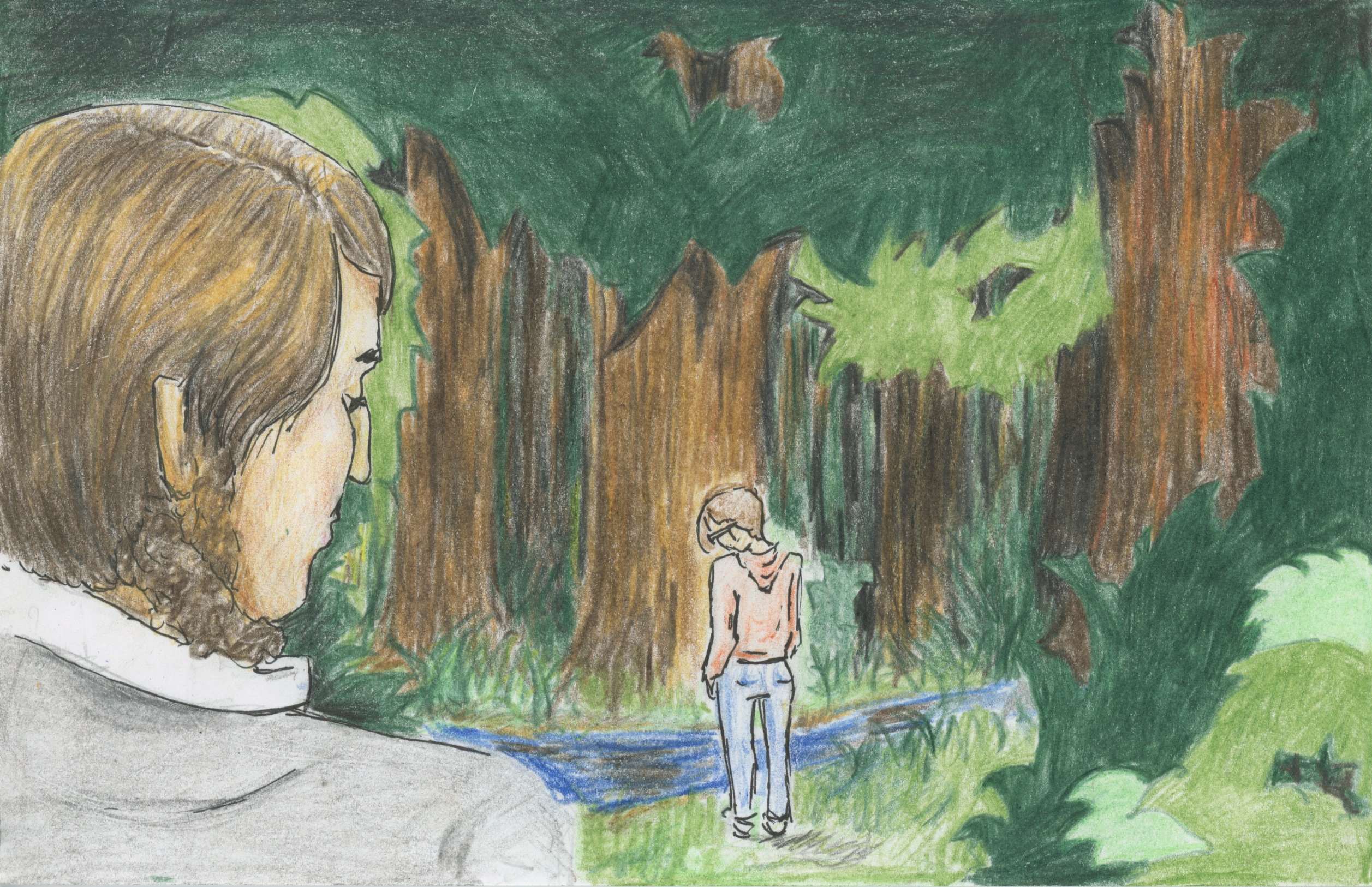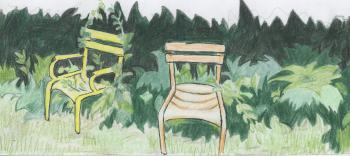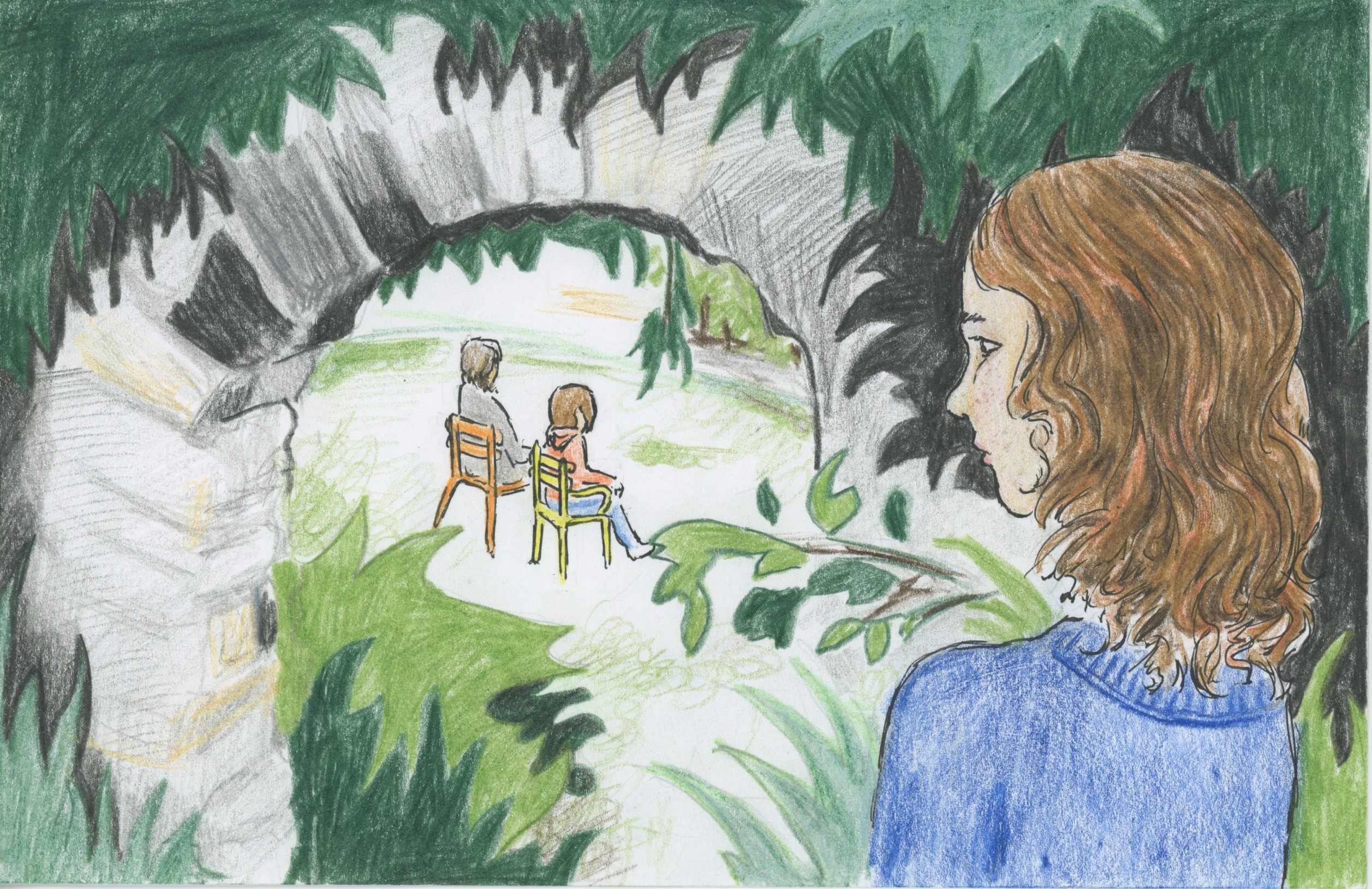Serendip is an independent site partnering with faculty at multiple colleges and universities around the world. Happy exploring!
Thoreau Children's Story

Henry Takes a Walk: A Thoreauvian Storybook
Written by: Emma Thorp
Illustrated by: Sara Gladwin
Henry began to walk at the top of the long hill above the pond. Directions and destinations were not on his mind. He decided to see where this grassy slope would lead.
Henry wandered along side the pond’s banks, wondering where the ripples came from below the surface.
Several flat, gray paths lead him to a white house hidden among a green jungle. Instead of going through the front door, he followed a steep slope down to a small, muddy bank by a trickling creek.

Someone was leaning over the creek, watching the water skim over the slippery pebbles
Henry knelt down beside Someone, as they stared at the water’s clear surface. They wondered where it came from, and where it was in such a rush to get going.

Someone and Henry climbed back up the hill, coasting down the incline on the other side. They sauntered until they encountered a tan house atop a tall hill. A grassy garden sat beside the house. Henry and Someone entered the green clearing and ach chose a rusty chair to sit upon.

Sara came upon them from another entrance to the enclosed space. She saw Someone and Henry sit on the chairs, and the chairs nestle deep into the vines and leaves on the ground beneath them.
She sank into a chair beside Henry and Someone, merging into the chair as the chair merged in among flowers and fallen berries. They listened to the whispering wind shake low trees and high bushes, feeling warm light from above. When all was still, they rose from the chairs, wandering away from the garden to find another place to sit.



Comments
This is such a great idea!
This is such a great idea! The pictures really complement the complex simplicity of the text. Complex, in that you are discussing Thoreau, and simple in that you seem to express the quiet, meditative feeling that experienced on your walk.
This is Amazing!
I love the simplicity of the story and the images are stunning! You guys did a great job! I love the subtlety
Reflections on writing a picture book
sara.gladwin:
So last night Emma and I decided we wanted to try out children’s literature as a genre. We brainstormed for a way to retell our Thoreauvian walks through a picture book. After drafting an outline, Emma wrote the story and captions while I worked on the illustrations. While I was not able to draw my intended six pages, I finished three full pages of the book.
Writing a children’s book was a very interesting experience. Emma and I both had our own separate goals in mind; I was interested in drawing more freely, which I was forced to do by this exercise. We made very conscious decisions about the book; what words we used, how it progressed, what scenes we used. While we attempted to remain directionless in our writing, we still unconsciously assigned a chronological order to the story. The story begins with young Henry, begins walking and eventually comes upon “Someone.” Someone and Henry continue to walk until they met Sara. We realized later that we had accidently ordered the scenes according to how many people where in them, going from one person, to two people, to finally three people. We avoided words that implied a direction such as “path” or expectations.
Another really fascinating aspect of this was the arrangement of the words themselves. When we first began to talk about the writing, we were deciding between two alternative beginning sentences. The first choice was one sentence with two thoughts joined together, while the second choice had separated both thoughts into different sentences. We ultimately decided on the second option, for several reasons. It sounded better, but also letting the two thoughts stand alone allowed it to be more powerful, the separation allowed for more resonance to take place between the thoughts.
As an artist that generally only draws people, drawing landscape was a challenge alone. I was not used to having to fill a piece of paper, I usually always have the comfort of blank, unused space on the page. I feel so much less pressure to continue drawing, no attachment. However, with this, I felt like I absolutely had to fill the page, or I wasn’t being “true” to the scenes we were trying to portray.
ekthorp:
Reflections on Writing Children’s Genre
For me, the concept of switching genres was difficult to comprehend. Elaborately moving modes was the only real way I could understand such a broad change. Following through with it made me understand elemental aspects of the process much more.
While writing, Sara and I attempted to open up everything: the plot, the sentence structure, the word meanings. We eventually found ourselves in a story with no real point of conflict or struggle. Isn’t this idealistic, of course, as strife really does occur? But we wanted to portray a story about interactions, between characters and between environments. We wanted to create space for those moments in between idealistic and realistic.
In several of our readings, I’ve encountered references to the education system, and assumptions that young ages are not able to integral notions of our interactions with nature. This is prevalent in the Schleppegrell/Goatly correspondence, and especially in Berry. I fundamentally disagree with this concept, and tried to integrate challenging concepts of the way our nature works. I tried to open up spaces and interaction in several ways, both in structure and syntax.
Some of the concepts we tried to introduce included the de-centering of interactions, disestablishment of anthropocentricity, and creation of ambiguity for accessibility. We tried to introduce concepts that will make room for understanding our complete interdependence on plants and the natural world. We attempted to eliminate modern notions of “the hero” and “protagonist/antagonist”. We came up with a simple yet probing story that asked subtle questions.